June marked the 25th Anniversary of Gramercy! Thank you to our valued investors, trusted business partners and team members without whom this milestone could not have been reached. We are excited for the opportunities we see ahead, and look forward to continuing to deliver upon our mission to have a positive impact on the well-being of our clients, portfolio investments (and their communities) and our team members.
Contents
Market Overview
Macro Review
Christmas came early for markets this week when the Federal Reserve gave a clear signal that the time for unwinding of the post-pandemic monetary policy tightening is likely coming in 2024. Investors rejoiced at the Fed’s dovish pivot and quickly priced in six cuts next year versus the Fed’s projected three. Futures markets are now fully pricing in a first rate cut in March, with around 20% probability of a cut as early as January. Did Chairman Powel go too far in his remarks, and will he need to walk some of the optimism back in coming weeks? One way or another, the divergence that has opened up between Fed projections and market expectations about the pace of policy easing in 2024 will have to be resolved. Meanwhile, the ECB and BoE signaled they do not intend to follow the Fed’s lead and start their own cutting cycles as soon as market participants expect, despite their sluggish economies. The EUR gained versus the USD as a result. In EM, the Central Banks of Brazil (-50bps to 11.75%), Peru (-25bps to 6.75%), and Ukraine (-100bps to 15%) reduced rates, while Mexico (11.25%), Philippines (6.5%), and Taiwan (1.875%) remained on hold. The Central Bank of Russia hiked by 100bps to 16% facing mounting inflationary pressures in its economy. Elsewhere of note, President Javier Milei formally assumed office in Argentina and immediately introduced the first batch of his promised “shock therapy” economic adjustment measures, including a 54% devaluation of the currency and a fiscal package targeting 5% of GDP consolidation in 2024. Meanwhile, presidents Maduro of Venezuela and Ali of Guyana met face-to-face on neutral territory in St. Vincent and the Grenadines to discuss Venezuela’s territorial claims over Guyana’s vast, oil-rich, Essequibo region and signaled a strong desire to finding a peaceful resolution to the dispute.
EM Credit Update
Capitalizing on the UST yields’ shift lower, emerging markets hard currency sovereign credit (cash bonds) ended the week sharply higher by 2.4% with spreads 6 bps tighter. Corporate credit was 1.4% stronger this week despite spreads being 3bps wider. Sovereign outperformers over the week included Ethiopia, Tunisia, and Argentina while Ukraine, Ecuador, and Bolivia underperformed. Amid the Fed’s dovish pivot and USD weakness, EM local debt gained 1.4% this week.
The Week Ahead
As 2023 comes to a close, the last pre-holiday week of the year offers some data points that could shed some light on which direction the Fed versus markets divergence in terms of 2024 policy easing pace and scale is likely to be resolved. U.S. housing transactions data are likely to show that activity remains weak due to lack of affordability, while the Fed’s favorite inflation measure – the core personal consumer expenditure deflator, is expected to be more benign that the latest Core CPI print. In EM, there will be a flurry of macro data from Poland, while in neighboring Hungary the Central Bank is expected to continue its rate-cutting cycle by another 75bps that would bring the policy rate to 10.75%. Focus will be on Turkey where the market consensus expects a 250bps rate hike to 42.5% by the Central Bank. In Asia, the last few highlights of 2023 include rate decisions from China, Japan and Indonesia.
Highlights from emerging markets discussed below: The Milei Administration reveals first batch of economic adjustment measures in Argentina and Venezuela and Guyana’s leaders meet face-to-face, signal desire to ensure peace.
Fixed Income
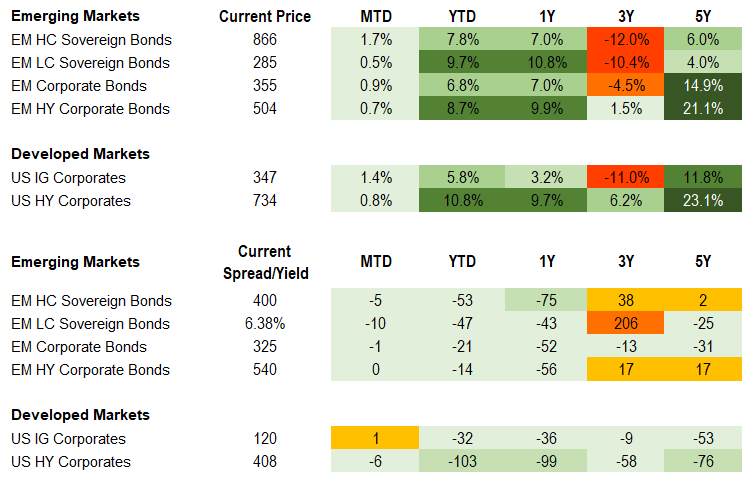
Equities
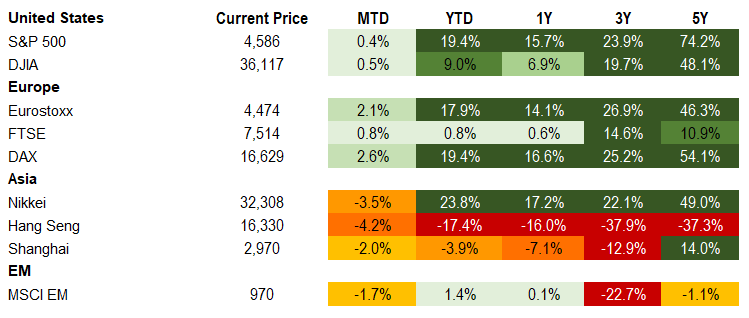
Commodities

Source for data tables: Bloomberg, JPMorgan, Gramercy. EM Fixed Income is represented by the following JPMorgan Indicies: EMBI Global, GBI-EM Global Diversified, CEMBI Broad Diversified and CEMBI Broad High Yield. DM Fixed Income is represented by the JPMorgan JULI Total Return Index and Domestic High Yield Index. Fixed Income, Equity and Commodity data is as of December 15, 2023 (mid-afternoon).
Emerging Markets Weekly Highlights
The Milei Administration reveals first batch of economic adjustment measures in Argentina
Event: Two days after assuming office on December 10th, President Javier Milei’s Administration unveiled its initial package of measures aimed at stabilizing Argentina’s fragile macroeconomic environment. The new Administration announced a significant 54% devaluation of the official exchange rate and targets a massive fiscal adjustment of approximately 5% of GDP in 2024 to balance the sovereign’s budget.
Gramercy Commentary: As signaled by Milei during his pre-election campaign, the adjustment announced by Economy Minister Luis Caputo targets a heavy fiscal consolidation anchored by both expenditure cuts and measures to mobilize additional revenues. It is complemented by a sizable nominal realignment (~54%) of the official FX rate to ~800 versus USD. With respect to budget spending cuts, notable measures include reducing the number of ministries to nine from 18, minimizing discretionary transfers to provinces, suspending public works, and reducing subsidies on energy and transportation prices. To counterbalance such socially sensitive austerity measures, the Milei Administration plans to increase spending on key social programs. However, as inflation likely escalates in the near-term driven by liberalized prices across the economy, there are significant questions around the Milei Administration’s ability to maintain governability and domestic political stability. Political and/or social turmoil represents the main risk to Milei’s aggressive economic adjustment program as it attempts to tackle long-standing macroeconomic and financial imbalances.
Venezuela and Guyana’s leaders meet face-to-face, signal desire to ensure peace
Event: Venezuela’s President Nicolas Maduro and his Guyana counterpart Irfaan Ali met on neutral territory in the small Caribbean island nation of Saint Vincent and the Grenadines to discuss Venezuela’s claims over Guyana’s vast, minerals-rich, Essequibo region.
Gramercy Commentary: The face-to-face meeting between the two heads of state comes in the context of heightened noise around Venezuelan claims of sovereignty over Essequibo following a recent referendum marked by low turnout. We read the meeting as a sign of de-escalation that further corroborates our view shared in last week’s edition that a military confrontation between the South American neighbors seems highly unlikely, despite bellicose rhetoric by the authorities in Caracas. Ahead of the meeting that took place at Argyle International Airport on St. Vincent, President Maduro appeared committed to reassure regional and global powers such as Brazil and the U.S. that have been applying diplomatic pressure to avoid the possibility of a conflict. “We will make the most of the meeting so that our Latin America and Caribbean remains a zone of peace”, Maduro stated. For its part, the Guyana Government pointed out that “regional leaders concurred with Guyana’s position”. Overall, as argued before, we believe that the situation around the Essequibo has been engineered by the Maduro regime for domestic political gain and carries little market relevance or probability of turning into a serious crisis. Meanwhile, the authorities in Caracas have announced a doubling of the national budget for 2024 on the back of significantly higher revenues since the Biden Administration eased sanctions on the oil sector back in October. The ability to increase social spending ahead of general and presidential elections expected in the second part of 2024 is critically important for Maduro’s political survival, which signals to us that the Administration will remain strongly incentivized to not cross any of U.S.’s red lines on which sanctions relief is conditioned.
Emerging Markets Technicals
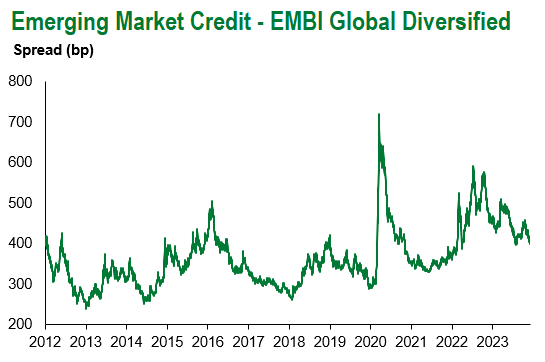
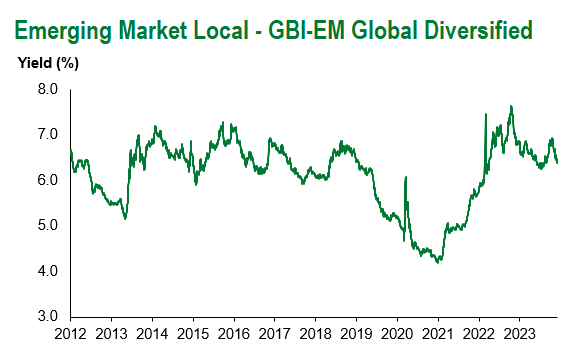
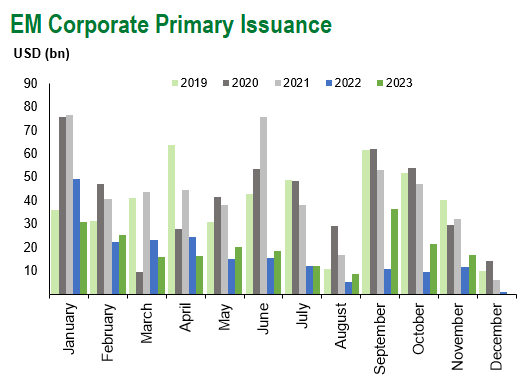
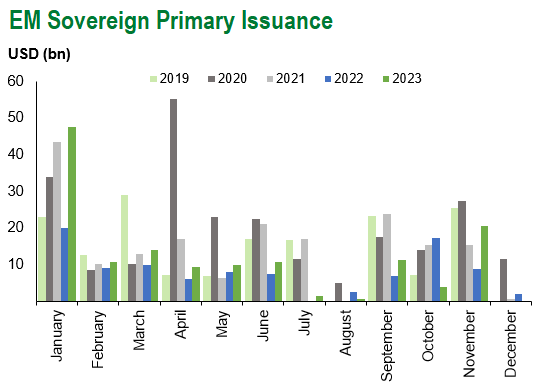
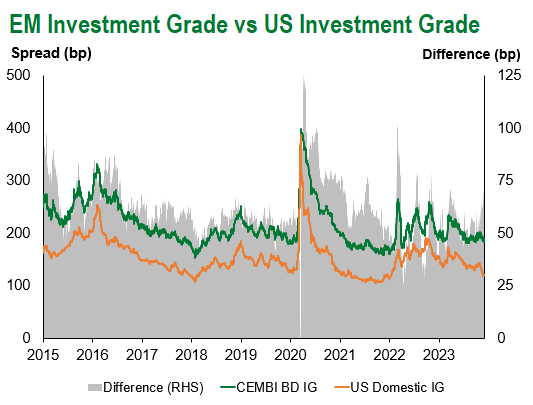
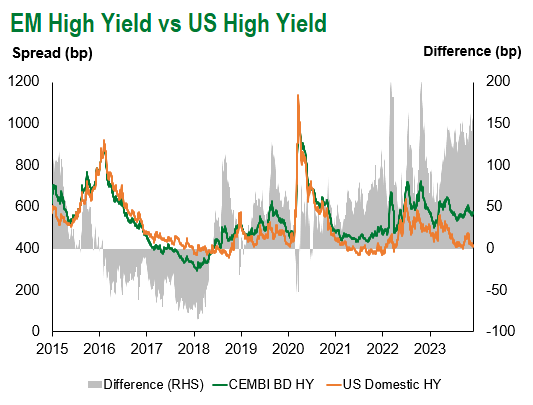
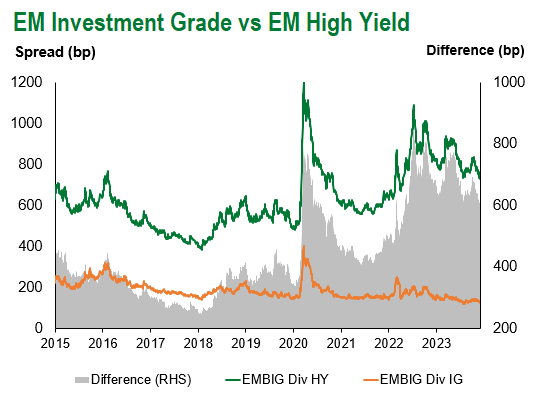
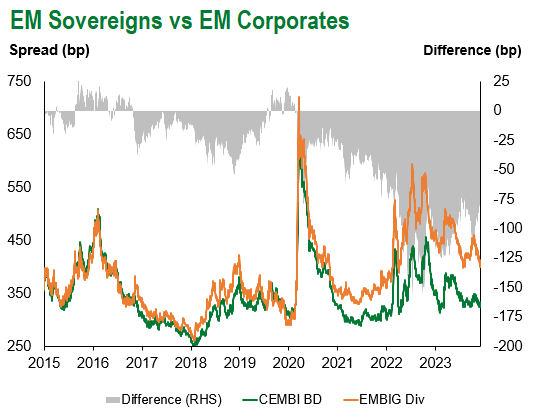
Emerging Markets Flows
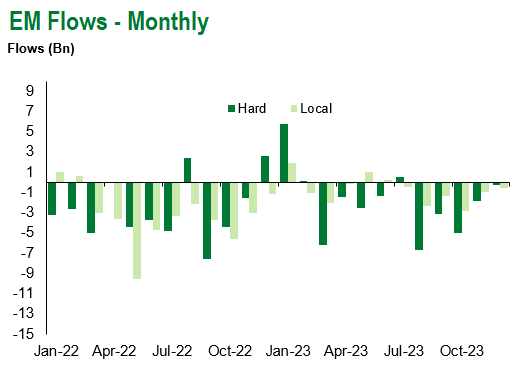
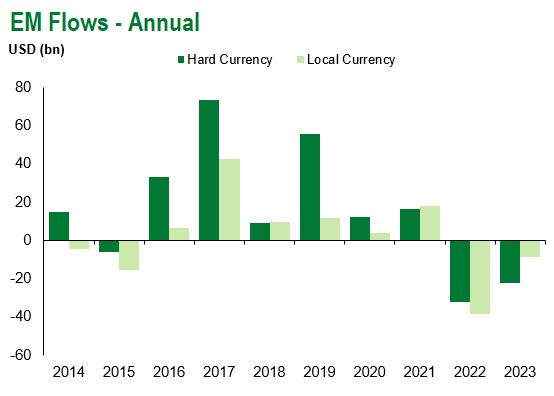
Source for graphs: Bloomberg, JPMorgan, Gramercy. As of December 15, 2023.
For questions, please contact:
Kathryn Exum, CFA ESG, Director, Co-Head of Sovereign Research, [email protected]
Petar Atanasov, Director, Co-Head of Sovereign Research, [email protected]
James Barry, Director, Deputy Portfolio Manager, [email protected]
This document is for informational purposes only. The information presented is not intended to be relied upon as a forecast, research or investment advice, and is not a recommendation, offer or solicitation to buy or sell any securities or to adopt any investment strategy. Gramercy may have current investment positions in the securities or sovereigns mentioned above. The information and opinions contained in this paper are as of the date of initial publication, derived from proprietary and nonproprietary sources deemed by Gramercy to be reliable, are not necessarily all-inclusive and are not guaranteed as to accuracy. This paper may contain “forward-looking” information that is not purely historical in nature. Such information may include, among other things, projections and forecasts. There is no guarantee that any forecasts made will come to pass. Reliance upon information in this paper is at the sole discretion of the reader. You should not rely on this presentation as the basis upon which to make an investment decision. Investment involves risk. There can be no assurance that investment objectives will be achieved. Investors must be prepared to bear the risk of a total loss of their investment. These risks are often heightened for investments in emerging/developing markets or smaller capital markets. International investing involves risks, including risks related to foreign currency, limited liquidity, less government regulation, and the possibility of substantial volatility due to adverse political, economic or other developments. References to any indices are for informational and general comparative purposes only. The performance data of various indices mentioned in this update are updated and released on a periodic basis before finalization. The performance data of various indices presented herein was current as of the date of the presentation. Please refer to data returns of the separate indices if you desire additional or updated information. Indices are unmanaged, and their performance results do not reflect the impact of fees, expenses, or taxes that may be incurred through an investment with Gramercy. Returns for indices assume dividend reinvestment. An investment cannot be made directly in an index. Accordingly, comparing results shown to those of such indices may be of limited use. The information provided herein is neither tax nor legal advice. Investors should speak to their tax professional for specific information regarding their tax situation.
